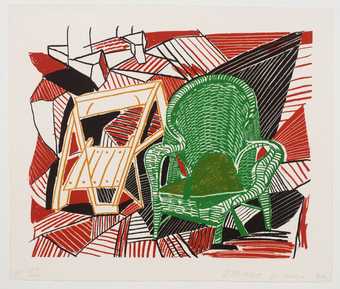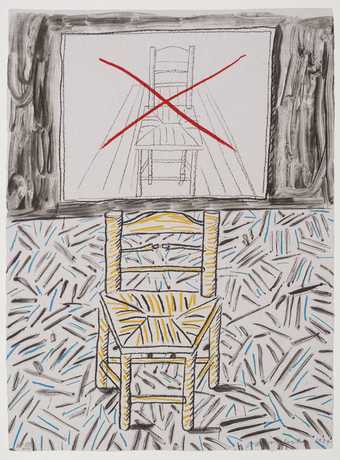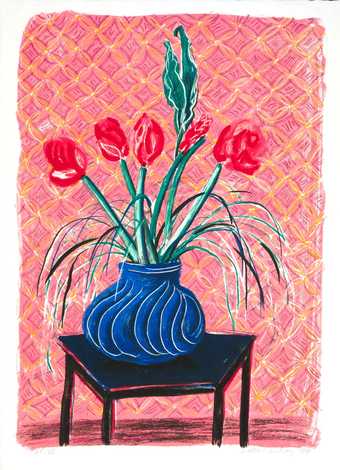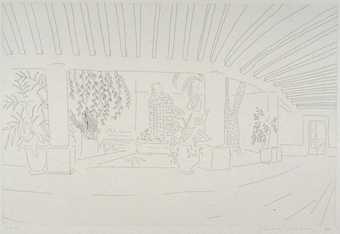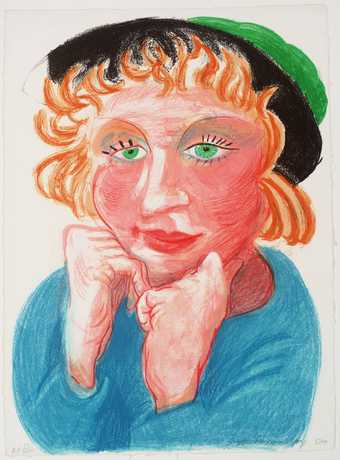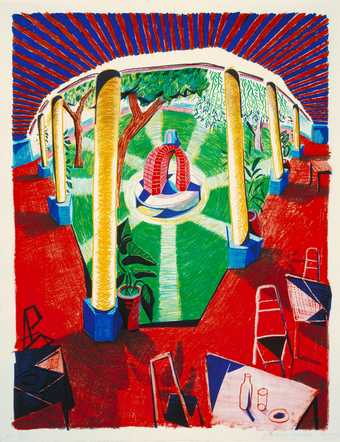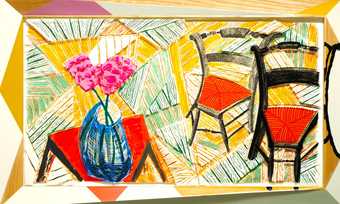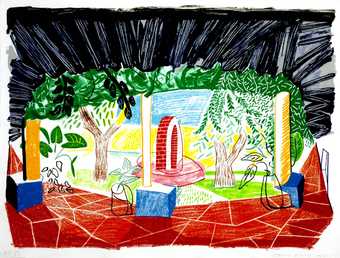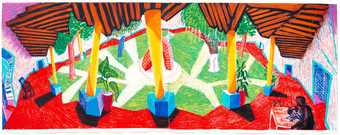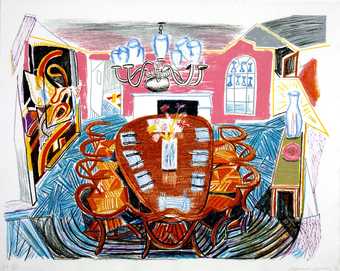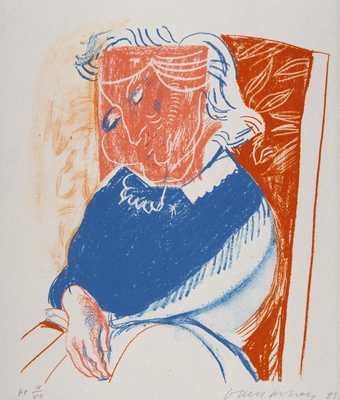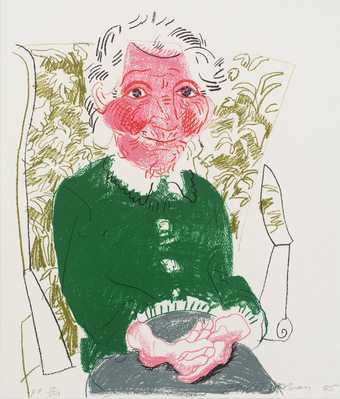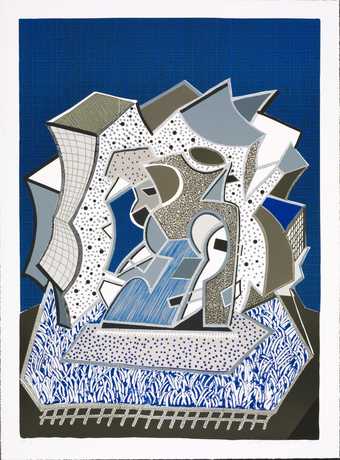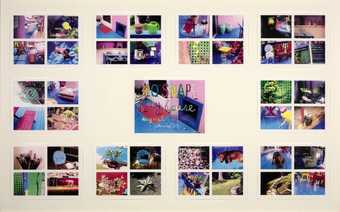
Not on display
- Artist
- David Hockney born 1937
- Medium
- Lithograph on paper
- Dimensions
- Image: 735 × 962 mm
- Collection
- Tate
- Acquisition
- Presented by the artist 1993
- Reference
- P20113
Summary
Printed on two sheets of paper joined together at the centre, this large lithograph by the British artist David Hockney presents a panoramic and brightly coloured view of a hotel and its courtyard in the Mexican town of Acatlán, where the artist twice stayed in 1984. In the far left of the image a red brick archway on a circular yellow platform marks the presence of a well. Three brown tree trunks stand in the centre of the courtyard on a purple-coloured ground flecked with vegetation, including some prominent green leaves. The hotel’s veranda, which has yellow columns and pink flooring with a red border, wraps around to the right of the composition, covering a sequence of green doors. The panoramic viewpoint provides the viewer with more visual information than would be experienced if the scene were observed in reality. Hotel Acatlan: Second Day 1984–5 was produced in an edition of ninety-eight, and is signed and dated in its bottom right-hand corner.
Hotel Acatlan: Second Day is part of a series of works – which includes six lithographic prints (four of which are held by Tate), an etching (Mexican Hotel, Acatlan 1984, Tate P20107) and an oil painting – that Hockney produced in 1984 and 1985 depicting the Hotel Romano Angeles in Acatlán. Living in Los Angeles at the time, Hockney travelled to Mexico City in February 1984 for the opening of his exhibition Hockney Paints the Stage at the Museo Rufino Tamayo. After seeing the show, the car he was travelling in from Mexico City to Oaxaca broke down, and the artist decided to stay at the Hotel Romano Angeles. Hockney made some initial sketches of the hotel before returning to California, where he completed the oil painting A Walk around the Hotel Courtyard, Acatlan 1985 – a large panoramic work painted across two canvases, which the artist claims ‘is not about a hotel, but about an attitude to space’ (Hockney 1993, p.157). He returned to the same hotel for a week’s stay in September 1984 accompanied by the printer Kenneth Tyler (the subject of Hockney’s An Image of Ken 1985, Tate P20120), during which time the artist worked outside on this and the other lithographic prints in the series.
The lithographs Hockney produced of the hotel in Acatlán utilised a new printing technique developed by Tyler, which involved the artist making sketches with rich inks and crayons on layers of plastic (known as Mylar sheets). For each colour employed in the work Hockney used an individual sheet, the transparency of which allowed him to maintain an idea of how various layers contributed to the overall effect. As Tyler explains, ‘The “Mylar layering” system was portable and liberating; it meant the artist could draw the printing elements outside of the workshop, whenever they pleased’ (quoted in Lloyd 2014, p.120). The Mylar sheets were transferred to aluminium plates, proofed and printed in Tyler’s workshop in Bedford, New York. Hotel Acatlan: Second Day was printed from forty-eight aluminum plates in twenty-eight colours.
Hockney subsequently used this printing technique for a series of twenty-nine large works (which include portraits, still lives and domestic interiors, as well as the depictions of the hotel in Acatlán) titled Moving Focus, completed between 1984 and 1987. Tyler claims the series ‘set a record for the number of printing elements made (a total of 577) with some 500 colours printed’ (quoted in Lloyd 2014, p.120). Curator Craig Hartley has argued of the Moving Focus series, ‘The scale of these prints was necessary to involve the spectator in each of the viewpoints as he shifts his position and focus. Big, bold and immediate; the medium and the artistic method are perfectly matched’ (Craig Hartley, ‘David Hockney: Printmaking and Technique’, in CCA Galleries 1990, p.7).
The Moving Focus series can be seen in the context of Hockney’s investigations during the 1980s into the relationship between objective observations of space and more imaginative representations, often based on memories. In 1982 the artist began creating photographic collages that offer composite, fragmented images of locations such as the Grand Canyon and a Japanese rock garden. These works, like those in the Moving Focus series, offer a more dynamic, rather than objective, notion of visual perception, influenced by cubism and the work of Pablo Picasso in particular. As Hockney explained in an interview with the artist and film-maker Paul Joyce, which took place in May 1984 during his trip to Mexico:
Memory must be part of vision, because everything is now. The past is now. Because each of us has a different memory, this proves to me that objective vision cannot be. When you look at this, you remember that you’ve seen things like it before. Your memory comes in and forms part of it, contradicting the objectivity of vision.
(Quoted in Paul Joyce, Hockney on ‘Art’: Conversations with Paul Joyce, London 1999, p.56.)
Further reading
David Hockney: 25 Years of Printmaking, exhibition catalogue, CCA Galleries, London 1990, p.7, reproduced no.8.
David Hockney, That’s the Way I See It, ed. by Nikos Stangos, London 1993, pp.154–7, reproduced p.156.
Richard Lloyd, Hockney: Printmaker, exhibition catalogue, Dulwich Picture Gallery, London 2014, pp.29–31, 120–1, 130–4.
Louise Hughes
March 2014
Supported by Christie’s.
Does this text contain inaccurate information or language that you feel we should improve or change? We would like to hear from you.
Explore
- architecture(30,960)
-
- features(8,872)
-
- arch(924)
- column(444)
- stair / step(514)
- garden structures(1,939)
-
- garden(1,191)
- residential(5,553)
-
- hotel(333)
- formal qualities(12,454)
-
- colour(836)
- Mexico(73)
You might like
-
David Hockney Two Pembroke Studio Chairs
1984 -
David Hockney The Perspective Lesson
1984 -
David Hockney Amaryllis in Vase
1984 -
David Hockney Mexican Hotel, Acatlan
1984 -
David Hockney Celia with Green Hat
1984 -
David Hockney Views of Hotel Well III
1984–5 -
David Hockney Walking Past Two Chairs
1984–6 -
David Hockney Views of Hotel Well I
1984–5 -
David Hockney Hotel Acatlan: Two Weeks Later
1985 -
David Hockney Tyler Dining Room
1984 -
David Hockney Portrait of Mother II
1985 -
David Hockney Portrait of Mother I
1985 -
David Hockney White Porcelain
1985–6 -
David Hockney Deux (Second Part)
1991 -
David Hockney 40 Snaps of my House, August 1990
1990

